Carl Zeiss Otus 55 mm f/1.4 ZE/ZF.2
3. Build quality
You can clearly notice that the older constructions feature 7 elements positioned in 6 groups, the Nikkor has 9 elements and the Zeiss Otus – as many as 12. It’s a lot for a 50 mm class device. The Otus is also without doubt physically the biggest and the heaviest lens in this group – it is so big that its weight and dimensions exceed those of the Zeiss Apo Sonnar 2/135 ZF.2, tested by us not so long ago. You can get some rough opinion about its size while glancing at this photo, with the tested lens positioned between the Macro-Planar 2.0/50 ZF.2 and the Nikkor AF 1.8/50D.
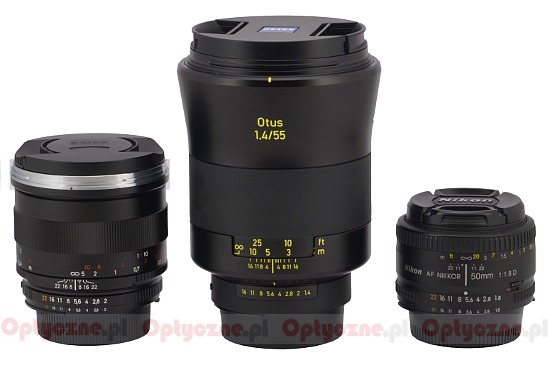 |
Please Support UsIf you enjoy our reviews and articles, and you want us to continue our work please, support our website by donating through PayPal. The funds are going to be used for paying our editorial team, renting servers, and equipping our testing studio; only that way we will be able to continue providing you interesting content for free. |
- - - - - - - - - - - - - - - - - - - - - - - - - - - - - - - - - - - - - - - - - - - - - - - -
The Zeiss Otus starts with a metal mount which surrounds the contacts and a rear element, 32 mm in diameter. That element is on the same level as the contacts when the focus is set at infinity; when you pass to the minimum focusing distance it hides by more than 0.5 of a centimeter inside the casing, not revealing any inner construction mechanical parts of the tube.
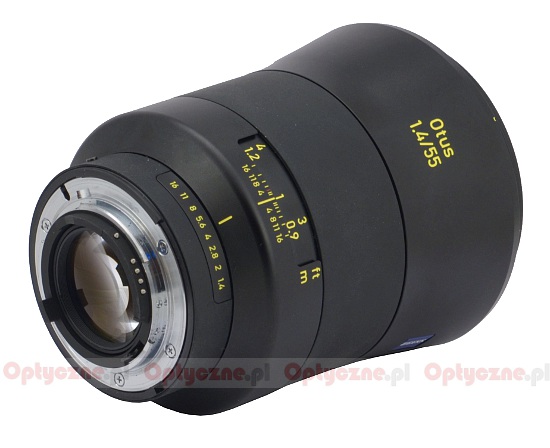 |
An aperture ring is the first element on the proper casing (we mean here the ZF.2 version). It is 13 mm wide, covered by black, smooth rubber which sticks well to your fingers. The ring moves every 0.5 EV step and is as well damped as it should. Of course you can also control the aperture from the level of the body and then it is possible to do so every 0.3 EV step.
The next part of the casing is made of metal, featuring a depth of field scale with the markings from f/16 to f/2.0 (but only values at f/16, f/11, f/8 and f/4 are undersigned). Over the depth of field scale there is a distance scale expressed in feet and meters; on the other side of it you can find the parameters of the lens, its serial number and the information that it was produced in Japan.
Further on you meet a manual focus ring. It is 32 mm wide and completely covered by smooth rubber. It sticks to your fingers very well so it is a joy to work with. Still there is a small drawback – it catches dirt easily as well. The working range of the ring amounts to 250 degrees, allowing you very precise settings. The comfort of using such a ring is really huge – the grip, the precision and the fluidity of the movements are impeccable.
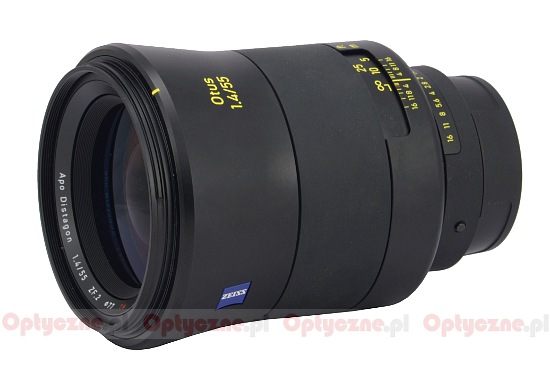 |
A big, immobile metal ring on which you can find the name and the parameters of the lens and the logos of the producer is the next part of the instrument. It turns smoothly into a hood mount.
The front element of the lens is immobile and 53 mm in diameter. It is surrounded by a ring with an inscription "ZEISS" and "Apo Distagon 1.4/55 ZF.2 o77 T*" and a non-rotating filter thread, 77 mm in diameter. These dimensions are truly impressive for a classic 50 mm f/1.4 lens.
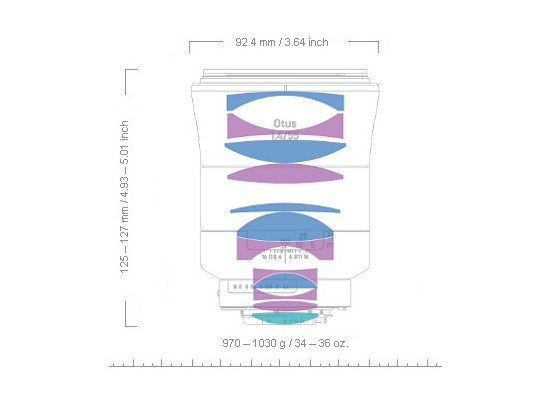 |
As we mentioned at the beginning of this chapter, the Zeiss Otus 1.4/55 mm is optically complex. Overall it consists of 12 elements positioned in 10 groups, an aspherical element among them and six elements made of untypical dispersion glass. Inside you can also find a circular aperture with nine diaphragm blades which can be closed down to a value of f/16.
Buyers get both caps and a metal hood. We regret, though, that the producer didn’t add any stylish case of a sort, or even a little protective suitcase. With such a price tag such an addition it would be more than justified.
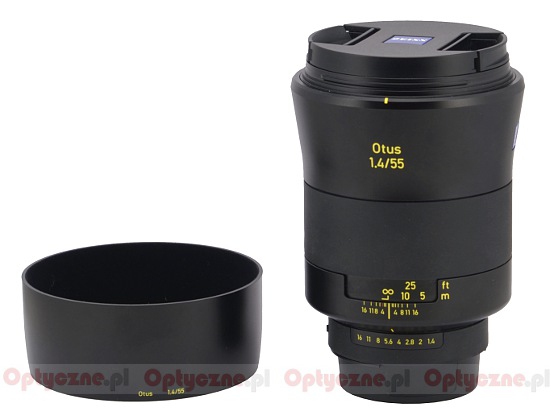 |






